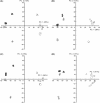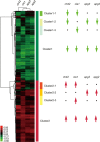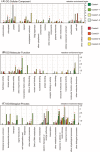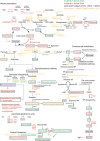Integrated analysis of transcriptome and metabolome of Arabidopsis albino or pale green mutants with disrupted nuclear-encoded chloroplast proteins
- PMID: 24793022
- PMCID: PMC4052017
- DOI: 10.1007/s11103-014-0194-9
Integrated analysis of transcriptome and metabolome of Arabidopsis albino or pale green mutants with disrupted nuclear-encoded chloroplast proteins
Abstract
We used four mutants having albino or pale green phenotypes with disrupted nuclear-encoded chloroplast proteins to analyze the regulatory system of metabolites in chloroplast. We performed an integrated analyses of transcriptomes and metabolomes of the four mutants. Transcriptome analysis was carried out using the Agilent Arabidopsis 2 Oligo Microarray, and metabolome analysis with two mass spectrometers; a direct-infusion Fourier transform ion cyclotron resonance mass spectrometer (FT-ICR/MS) and a gas chromatograph-time of flight mass spectrometer. Among approximately 200 known metabolites detected by the FT-ICR/MS, 71 metabolites showed significant changes in the mutants when compared with controls (Ds donor plants). Significant accumulation of several amino acids (glutamine, glutamate and asparagine) was observed in the albino and pale green mutants. Transcriptome analysis revealed altered expressions of genes in several metabolic pathways. For example, genes involved in the tricarboxylic acid cycle, the oxidative pentose phosphate pathway, and the de novo purine nucleotide biosynthetic pathway were up-regulated. These results suggest that nitrogen assimilation is constitutively promoted in the albino and pale green mutants. The accumulation of ammonium ions in the albino and pale green mutants was consistently higher than in Ds donor lines. Furthermore, genes related to pyridoxin accumulation and the de novo purine nucleotide biosynthetic pathway were up-regulated, which may have occurred as a result of the accumulation of glutamine in the albino and pale green mutants. The difference in metabolic profiles seems to be correlated with the disruption of chloroplast internal membrane structures in the mutants. In albino mutants, the alteration of metabolites accumulation and genes expression is stronger than pale green mutants.
Figures





Similar articles
-
The novel protein DELAYED PALE-GREENING1 is required for early chloroplast biogenesis in Arabidopsis thaliana.Sci Rep. 2016 May 10;6:25742. doi: 10.1038/srep25742. Sci Rep. 2016. PMID: 27160321 Free PMC article.
-
Chloroplast localization of methylerythritol 4-phosphate pathway enzymes and regulation of mitochondrial genes in ispD and ispE albino mutants in Arabidopsis.Plant Mol Biol. 2008 Apr;66(6):663-73. doi: 10.1007/s11103-008-9297-5. Epub 2008 Jan 31. Plant Mol Biol. 2008. PMID: 18236010
-
Functional analysis of the 37 kDa inner envelope membrane polypeptide in chloroplast biogenesis using a Ds-tagged Arabidopsis pale-green mutant.Plant J. 2003 Jun;34(5):719-31. doi: 10.1046/j.1365-313x.2003.01763.x. Plant J. 2003. PMID: 12787252
-
pTAC10, an S1-domain-containing component of the transcriptionally active chromosome complex, is essential for plastid gene expression in Arabidopsis thaliana and is phosphorylated by chloroplast-targeted casein kinase II.Photosynth Res. 2018 Jul;137(1):69-83. doi: 10.1007/s11120-018-0479-y. Epub 2018 Jan 12. Photosynth Res. 2018. PMID: 29330702
-
Seedling Lethal1, a pentatricopeptide repeat protein lacking an E/E+ or DYW domain in Arabidopsis, is involved in plastid gene expression and early chloroplast development.Plant Physiol. 2013 Dec;163(4):1844-58. doi: 10.1104/pp.113.227199. Epub 2013 Oct 21. Plant Physiol. 2013. PMID: 24144791 Free PMC article.
Cited by
-
Peptide chain release factor DIG8 regulates plant growth by affecting ROS-mediated sugar transportation in Arabidopsis thaliana.Front Plant Sci. 2023 Mar 31;14:1172275. doi: 10.3389/fpls.2023.1172275. eCollection 2023. Front Plant Sci. 2023. PMID: 37063204 Free PMC article.
-
Metabolomics analysis reveals the metabolic and functional roles of flavonoids in light-sensitive tea leaves.BMC Plant Biol. 2017 Mar 20;17(1):64. doi: 10.1186/s12870-017-1012-8. BMC Plant Biol. 2017. PMID: 28320327 Free PMC article.
-
Transcriptomic, proteomic and metabolic changes in Arabidopsis thaliana leaves after the onset of illumination.BMC Plant Biol. 2016 Feb 11;16:43. doi: 10.1186/s12870-016-0726-3. BMC Plant Biol. 2016. PMID: 26865323 Free PMC article.
-
Chlorophyll fluorescence-based high-throughput phenotyping facilitates the genetic dissection of photosynthetic heat tolerance in African (Oryza glaberrima) and Asian (Oryza sativa) rice.J Exp Bot. 2023 Sep 13;74(17):5181-5197. doi: 10.1093/jxb/erad239. J Exp Bot. 2023. PMID: 37347829 Free PMC article.
-
Purine nucleotide biosynthetic gene GARS controls early chloroplast development in rice (Oryza sativa L.).Plant Cell Rep. 2019 Feb;38(2):183-194. doi: 10.1007/s00299-018-2360-z. Epub 2018 Nov 29. Plant Cell Rep. 2019. PMID: 30499032
References
-
- Booij-James IS, Dube SK, Jansen MA, Edelman M, Mattoo AK. Ultraviolet-B radiation impacts light-mediated turnover of the photosystem II reaction center heterodimer in Arabidopsis mutants altered in phenolic metabolism. Plant Physiol. 2000;124:1275–1284. doi: 10.1104/pp.124.3.1275. - DOI - PMC - PubMed
Publication types
MeSH terms
Substances
LinkOut - more resources
Full Text Sources
Other Literature Sources
Molecular Biology Databases

